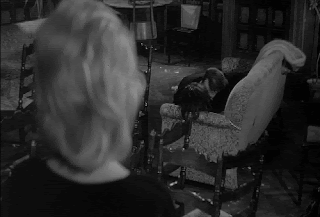L 'Avventura - The Adventure (1960) is an Italian cinematic masterpiece that takes audiences on a visual adventure.
Directed by Michelangelo Antonioni.
Starring Monica Vitti and Gabriele Ferzetti among many others.
The film was released at the same time as Federico Fellini's La Dolce Vita. Fellini and Antonioni started the Italian New Wave. Both films were introduced at the 1960 Cannes Film Festival. Fellini's film won the Palme D'Or while L'Avventura took The Jury Prize.
The cinematography was by Aldo Scavarda and the editing by Eraldo Da Roma. I mention the cinematographer and the editor, because their work is so integral to the adventure Michelangelo takes his audience on.
L'Avventura is easy to understand if you allow the film's visuals and its long scenes (which lack the modern "Jump Cut" edits, created by Jean-Luc Godard for Breathless) to create your own story and narrative. The opening scene below is a perfect illustration of what Michelangelo, Aldo and Eraldo give the audience visually and editorially, so that the audience can make the adventure come alive for them individually. In the scene below the visuals not only help the audience to create their own story, but more importantly help Antonioni make scathing social commentaries on technology. Note the contrasting visuals between the old and the new in the scene. To the right we have an old sprawling villa with a magnificent Roman arch, whose surrounding Forrest's have been cut down to make way for modern tightly packed multi family housing. Also note the road that separates the old villa from the new apartment buildings heads towards a distant Renaissance Dome in the background. Antonioni is visually showing us the contrasts between the old ways and the new ways. There are many other contrasts between the old and new in the scene below, but I'll let Antonioni's visuals speak to you, so you can explore them for yourself and come up with your own story.
As an audience member I felt as liberated by this film as I do when I read a novel. Just as in a novel, Michelangelo keeps the dialogue simple and the visuals complex to allow me to explore his visuals at a readers pace, which like in a novel allows the audience member to create the story for themselves. Enjoy!
Directed by Michelangelo Antonioni.
Starring Monica Vitti and Gabriele Ferzetti among many others.
The film was released at the same time as Federico Fellini's La Dolce Vita. Fellini and Antonioni started the Italian New Wave. Both films were introduced at the 1960 Cannes Film Festival. Fellini's film won the Palme D'Or while L'Avventura took The Jury Prize.
The cinematography was by Aldo Scavarda and the editing by Eraldo Da Roma. I mention the cinematographer and the editor, because their work is so integral to the adventure Michelangelo takes his audience on.
L'Avventura is easy to understand if you allow the film's visuals and its long scenes (which lack the modern "Jump Cut" edits, created by Jean-Luc Godard for Breathless) to create your own story and narrative. The opening scene below is a perfect illustration of what Michelangelo, Aldo and Eraldo give the audience visually and editorially, so that the audience can make the adventure come alive for them individually. In the scene below the visuals not only help the audience to create their own story, but more importantly help Antonioni make scathing social commentaries on technology. Note the contrasting visuals between the old and the new in the scene. To the right we have an old sprawling villa with a magnificent Roman arch, whose surrounding Forrest's have been cut down to make way for modern tightly packed multi family housing. Also note the road that separates the old villa from the new apartment buildings heads towards a distant Renaissance Dome in the background. Antonioni is visually showing us the contrasts between the old ways and the new ways. There are many other contrasts between the old and new in the scene below, but I'll let Antonioni's visuals speak to you, so you can explore them for yourself and come up with your own story.
As an audience member I felt as liberated by this film as I do when I read a novel. Just as in a novel, Michelangelo keeps the dialogue simple and the visuals complex to allow me to explore his visuals at a readers pace, which like in a novel allows the audience member to create the story for themselves. Enjoy!
Trivia - At the 1959 premier at the Cannes Film Festival, Michelangelo and Monica fled the theater, because the of the violent reaction from the audience to their film. It went on to win a Special Jury Prize. La Dolce Vita by Federico Fellini won the Palme D'Or that year.

No comments:
Post a Comment